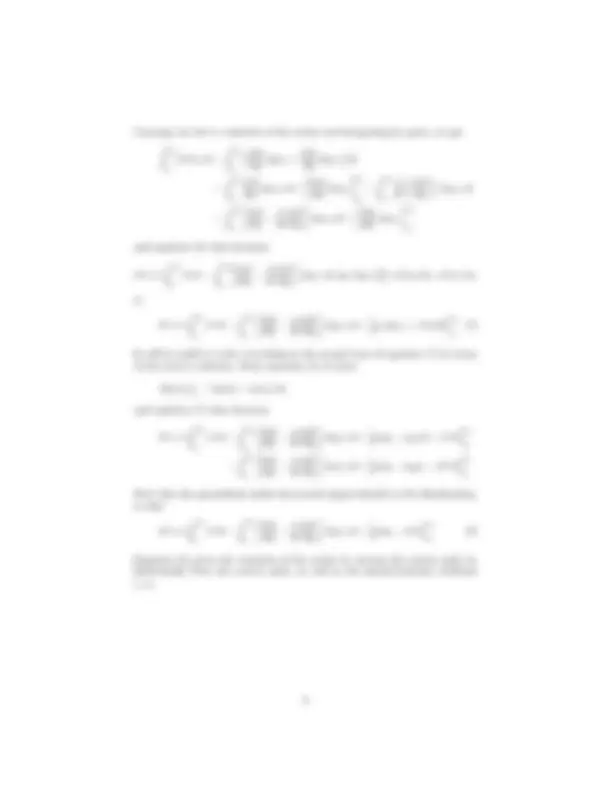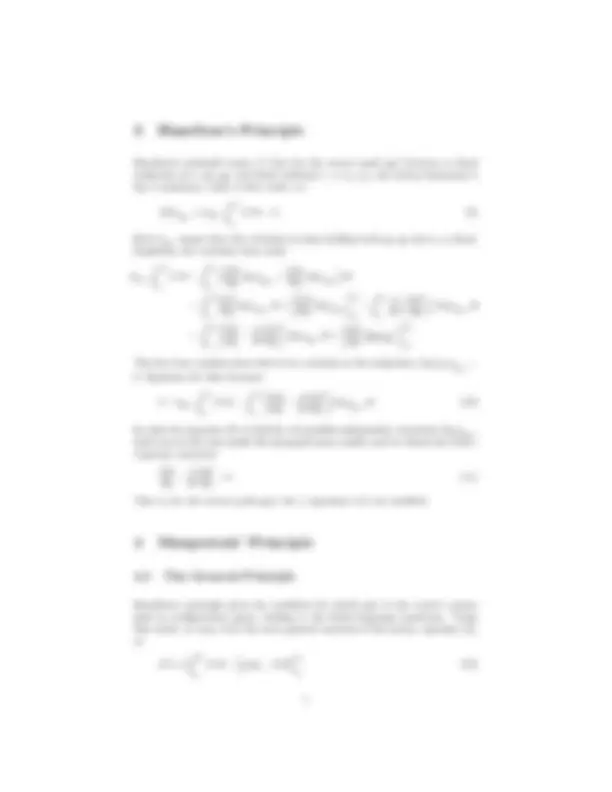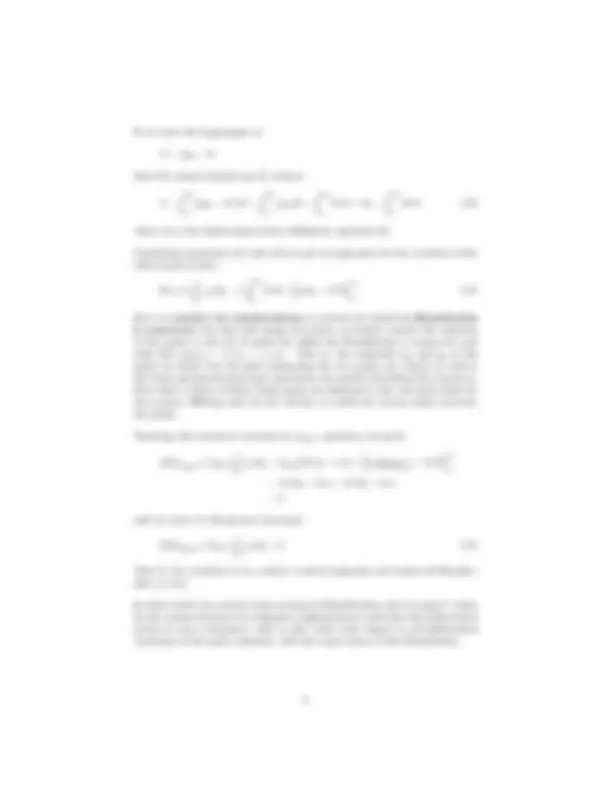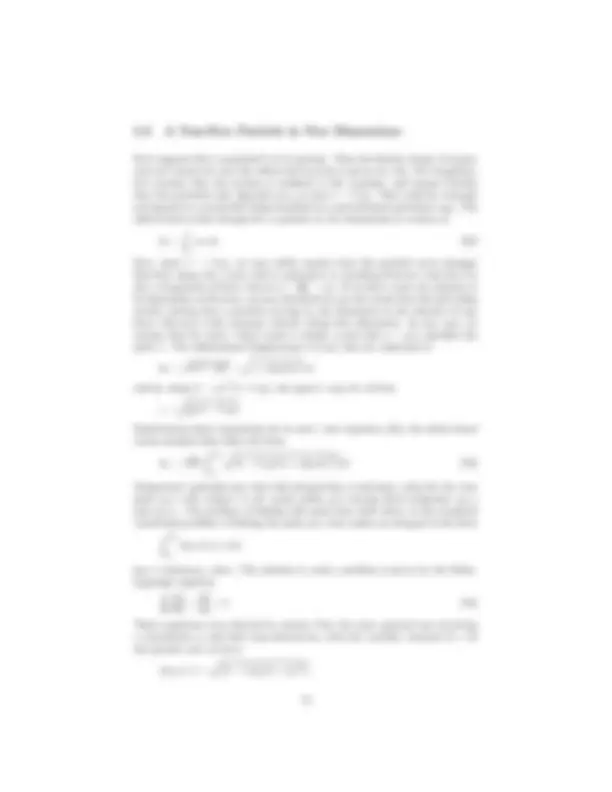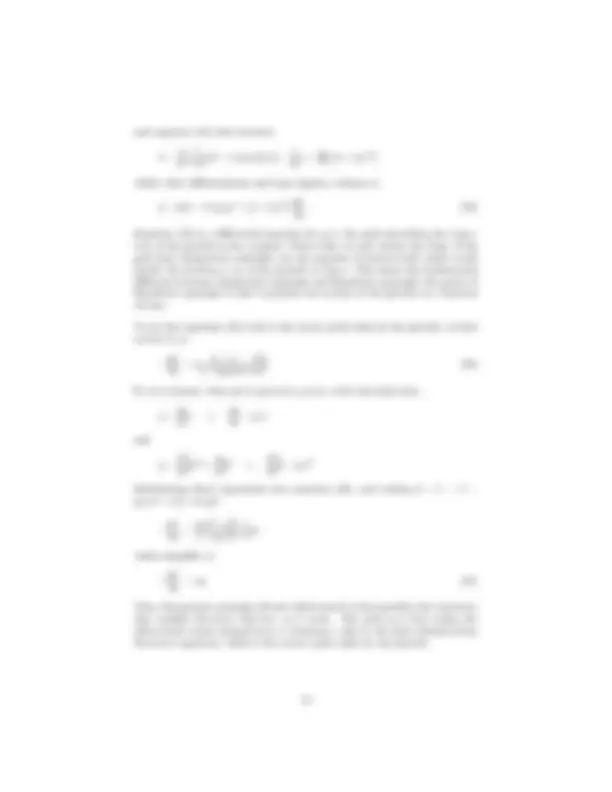Download Principle of Least Action: Maupertuis vs. Hamilton and more Study Guides, Projects, Research Dynamics in PDF only on Docsity!
The Principle of Least Action
Anders Svensson
Abstract
In this paper, the principle of least action in classical mechanics is
studied. The term is used in several different contexts, mainly for Hamil-
ton’s principle and Maupertuis’ principle, and this paper provides a dis-
cussion on the usage of the term in both of these contexts, before diving
deeper into studying Maupertuis’ principle, also known as the abbreviated
principle of least action.
Department of Engineering and Physics
Karlstad University
Sweden
January 19, 2015
Contents
- 1 Introduction
- 1.1 Some Historical Remarks
- 1.2 Definitions and Formal Statements of the Variational Principles
- 2 General Variation of the Action
- 3 Hamilton’s Principle
- 4 Maupertuis’ Principle
- 4.1 The General Principle
- 4.2 Some (still very general) special cases
- 5 Examples: Motion of a Single Particle
- 5.1 A Particle Moving in Three Dimensions
- 5.2 Free Particle in Three Dimensions
- 5.3 A Non-Free Particle in Two Dimensions
- 5.4 The Harmonic Oscillator
- 6 When is it Least?
- 7 Conclusion
q(t) of the system, whereas in Maupertuis’ principle only gives the shape of
the trajectories [5]. Also, Maupertuis’ principle requires that the energy (or,
more precisely, the Hamiltonian) is conserved over the varied paths, whereas
Hamilton’s principle does not. In modern terminology, the principle of least
action is most often used interchangeably with Hamilton’s principle.
In both Maupertuis’ principle and Hamilton’s principle, the action is not re-
quired to be at a minimum but, rather, have a stationary value [1]. Therefore
we may more correctly speak of the principle of stationary action, a name which
also occurs in modern texts.
With this historical introduction and discussion out of the way, we now start
with a few definitions and proceed in the next section with a general variational
method leading up to Maupertuis’ principle.
1.2 Definitions and Formal Statements of the Variational
Principles
- We consider systems with n degrees of freedom and holonomic con-
straints such that the forces of constraint do no net virtual work, and
assume that the system has n independent generalized coordinates
q 1 ,... , qn. We denote by q the ordered n-tuple of coordinates (q 1 ,... , qn),
or a column vector with entries qi.
- All applied forces are assumed to be derivable from a generalized scalar
potential U (q, q˙; t), and the total kinetic energy of the system is denoted
by T. The Lagrangian of the system is then defined by
L (q, q˙; t) = T − U
- The n-dimensional Cartesian hyperspace with axes q 1 ,... , qn is called con-
figuration space. A point q 0 in configuration space represents the sys-
tems configuration at some time t 0 , and the evolution of the system point
with time is described by a path q(t) in configuration space, parametrized
by time t.
- The action S is a functional defined by [4]
S[q(t)] :=
ˆ (^) t 2
t 1
L
q(t), q˙(t); t
dt (1)
taking as its argument a set of functions q(t) with endpoints q 1 = q(t 1 )
and q 2 = q(t 2 ), and returning a scalar.
- Hamilton’s principle or the principle of least (stationary) action
states that [1] [7], for the correct path q(t) taken by the system between
two endpoint configurations (q 1 , q 2 ) ≡ Q and fixed times (t 1 , t 2 ) ≡ τ ,
δS
Q,τ = 0
where
δS
Q,τ
denotes variation δS of the paths q(t) subject to fixed Q
and τ. In other words, for the correct path q(t) of the system point in
configuration space, the action S has a stationary value to first order
with respect to all neighbouring paths between the same events, differing
infinitesimally from the correct path.
- The canonical momentum pi conjugate to the coordinate qi is defined by
pi =
∂L
∂ q˙i
and we denote by p the ordered n-tuple of momenta (p 1 ,... , pn), or column
vector with entries pi. The Hamiltonian is then given by
H(q, p; t) = pi q˙i − L
- The abbreviated action S 0 is also a functional, defined by [4]
S 0 (C) :=
C
p • dq =
C
pi dqi =
ˆ (^) t 2
t 1
pi(t) ˙qi(t) dt (2)
Here the argument is the path C followed by the system point in config-
uration space with endpoints q 1 , q 2 , without regards to any particular
parametrization.
- Consider systems for which the Hamiltonian H is conserved. The modern
formulation of Maupertuis’ principle or the abbreviated principle
of least (stationary) action may be stated [6] as: For he correct path
taken by the system,
δS 0
Q,H = 0
where
δS 0
Q,H
denotes the variation δS of the path C in configuration
space subject to fixed endpoints (q 1 , q 2 ) ≡ Q and conserved Hamiltonian
H. Here the variation is done allowing changes in t 1 and t 2. In other
words, out of all possible paths for which the Hamiltonian is conserved,
the system takes that path which makes the abbreviated action S 0 have a
stationary value to first order with respect to all infinitesimally differing
paths between the same endpoints.
curve itself. We will however only be concerned with the endpoints of the path,
and the notations δQ and δτ stands for general δ-variations of the path with
the only restrictions being at the endpoints. The purpose of this discussion has
been to clarify the variational concepts and notations used. Now we can get to
business and perform the general variation of the action S.
If we let
L (α; t) ≡ L
q(t, α), q˙(t, α); t
and
L (0; t) ≡ L
q(t, 0), q˙(t, 0); t
then the variation of the action S is carried out as
δS ≡ δ
ˆ (^) t 2
t 1
L
q(t), q˙(t); t
dt ≡
ˆ (^) t 2 +δt 2
t 1 +δt 1
L (α; t) dt −
ˆ (^) t 2
t 1
L (0; t) dt (5)
We may rewrite equation (5) as
δS =
ˆ (^) t 2
t 1
L (α; t) dt +
ˆ (^) t 2 +δt 2
t 2
L (α; t) dt −
ˆ (^) t 1 +δt 1
t 1
L (α; t) dt −
ˆ (^) t 2
t 1
L (0; t) dt
ˆ (^) t 2
t 1
L (α; t) − L (0, t)
dt +
ˆ (^) t 2 +δt 2
t 2
L (α; t) dt −
ˆ (^) t 1 +δt 1
t 1
L (α; t) dt
= δτ
ˆ (^) t 2
t 1
L dt +
ˆ (^) t 2 +δt 2
t 2
L (α; t) dt −
ˆ (^) t 1 +δt 1
t 1
L (α; t) dt
where the first term is the variation in the action keeping the endtimes fixed.
To first order infinitesimals, the second and third integrals are
ˆ (^) t k+δtk
tk
L (α; t) dt = L (α; tk) δtk
[
L (0; tk) +
∂L
∂α
0
α
]
δtk
= L (0; tk) δtk +
∂L
∂α
0
�α δt��k
= L (tk) δtk
And thus we have
δS ≡ δ
ˆ (^) t 2
t 1
L dt = δτ
ˆ (^) t 2
t 1
L dt + L (t 2 ) δt 2 − L (t 1 ) δt 1 (6)
Looking at equation (6) we see that the variation just performed is composed of
two parts. The first term is the δτ -variation of the action integral, and the other
two terms are the values of the unvaried Lagrangian at the endtimes multiplied
by the variations in the endtimes.
Carrying out the δτ -variation of the action and integrating by parts, we get
ˆ (^) t 2
t 1
(δL )τ dt =
ˆ (^) t 2
t 1
∂L
∂qi
(δqi)τ +
∂L
∂ q˙i
(δ q˙i)τ
dt
ˆ (^) t 2
t 1
∂L
∂qi
(δqi)τ dt +
[
∂L
∂ q˙i
(δqi)τ
]t 2
t 1
ˆ (^) t 2
t 1
d
dt
∂L
∂ q˙i
(δqi)τ dt
ˆ (^) t 2
t 1
[
∂L
∂qi
d
dt
∂L
∂ q˙i
]
(δqi)τ dt +
[
∂L
∂ q˙i
(δqi)τ
]t 2
t 1
and equation (6) then becomes
δS ≡ δ
ˆ (^) t 2
t 1
L dt =
ˆ (^) t 2
t 1
[
∂L
∂qi
d
dt
∂L
∂ q˙i
]
(δqi)τ dt+[pi (δqi)τ ]
t 2 t 1 +L^ (t^2 )^ δt^2 −L^ (t^1 )^ δt^1
or
δS ≡ δ
ˆ (^) t 2
t 1
L dt =
ˆ (^) t 2
t 1
[
∂L
∂qi
d
dt
∂L
∂ q˙i
]
(δqi)τ dt +
[
pi (δqi)τ + L (t)δt
]t 2
t 1
It will be useful to write everything in the second term of equation (7) in terms
of the total δ-variation. From equation (4) we have
δqi(tk)
τ
= δqi(tk) − q˙i(tk) δtk
and equation (7) then becomes
δS ≡ δ
ˆ (^) t 2
t 1
L dt =
ˆ (^) t 2
t 1
[
∂L
∂qi
d
dt
∂L
∂ q˙i
]
(δqi)τ dt +
[
piδqi − pi q˙i δt + L δt
]t 2
t 1
ˆ (^) t 2
t 1
[
∂L
∂qi
d
dt
∂L
∂ q˙i
]
(δqi)τ dt +
[
piδqi −
pi q˙i − L
δt
]t 2
t 1
Note that the parenthesis inside the second square-bracket is the Hamiltonian,
so that
δS ≡ δ
ˆ (^) t 2
t 1
L dt =
ˆ (^) t 2
t 1
[
∂L
∂qi
d
dt
∂L
∂ q˙i
]
(δqi)τ dt +
[
piδqi − H δt
]t 2
t 1
Equation (8) gives the variation of the action in varying the system path in-
finitesimally from the correct path, as well as the parametrization endtimes
t 1 , t 2.
If we write the Lagrangian as
L = ˙qipi − H
then the action integral can be written
S =
ˆ (^) t 2
t 1
( ˙qipi − H) dt =
ˆ (^) t 2
t 1
pi q˙i dt −
ˆ (^) t 2
t 1
H dt = S 0 −
ˆ (^) t 2
t 1
H dt (13)
where S 0 is the abbreviated action defined by equation (2).
Combining equations (12) and (13) we get an expression for the variation of the
abbreviated action:
δS 0 ≡ δ
C
pi dqi = δ
ˆ (^) t 2
t 1
H dt +
[
piδqi − H δt
]t 2
t 1
Now we restrict our considerations to systems for which the Hamiltonian
is conserved. For this wide range of systems, we further restrict the variation
of the paths to the set of paths for which the Hamiltonian is conserved, and
such that δqi(tk) = 0 (tk = t 1 , t 2 ). That is, the endpoints q 1 and q 2 of the
paths are fixed, but the path connecting the two points are varied, as well as
the times parametrizations q(t) (and hence the speed) describing the trajectory.
Note that a subset of these varied paths are identical to the true path taken by
the system, differing only by the velocity at which the system point traverses
the paths.
Denoting this restricted variation by δQ,H , equation (14) gives
δS 0
Q,H
≡ δQ,H
C
pi dqi = δQ,H
[
H (t 2 − t 1 )
]
[
pi
δqi
Q,H
− H δt
]t 2
t 1
= H (δt 2 − δt 1 ) − H (δt 2 − δt 1 )
and we arrive at Maupertuis’ principle:
δS 0
Q,H ≡^ δQ,H
C
pi dqi = 0 (15)
That is, the variation in S 0 , subject to fixed endpoints and conserved Hamilto-
nian, is zero.
In other words, for systems with a conserved Hamiltonian, the true path C taken
by the system between two endpoint configurations is such that the abbreviated
action S 0 has a stationary value to first order with respect to all infinitesimal
variations of the path consistent with the conservation of the Hamiltonian.
4.2 Some (still very general) special cases
If the transformation equations ri = ri(q) that define the generalized coordinates
do not involve time explicitly, then the kinetic energy has the form
T =
Mjk(q) ˙qj q˙k
where the coefficients Mjk are in general functions of the generalized coordinates,
and are symmetric:
Mjk = Mkj
If, in addition, the potential V = V (q) is not velocity dependent, then the Hamil-
tonian will automatically be the same as the total energy [1]:
H = T + V
which is then conserved, since by assumption H is conserved.
Furthermore,
pi =
∂L
∂ q˙i
∂T
∂ q˙i
∂V
∂ q˙i
Mjk
∂ q˙j
∂ q˙i
q ˙k + ˙qj
∂ q˙k
∂ q˙i
Mjkδij q˙k +
Mjk q˙j δik =
Mik q˙k +
Mji q˙j
= Mij q˙j
and the abbreviated action becomes
C
pi dqi =
ˆ (^) t 2
t 1
pi q˙i dt =
ˆ (^) t 2
t 1
Mij q˙j q˙i dt =
ˆ (^) t 2
t 1
2 T dt
Hence, if the constraints are time-independent and the potential velocity-independent,
then Maupertuis’ principle becomes
δS 0
Q,E
= δQ,E
ˆ (^) t 2
t 1
2 T dt = 0 (16)
That is, for the correct path C taken by the system point between two con-
figurations, the integral of the kinetic energy over time has a stationary value
subject to the conservation of energy.
If, further, there are no external forces on the system (e.g. a rigid body with
no net applied forces), then the kinetic energy T will be conserved (along with
H) and then equation (16) simplifies to
δ(t 2 − t 1 )
Q,E
which is a principle of least time (or, more correctly, the time elapsed has a
stationary value). This also means that a free particle takes the shortest path,
i.e. a straight line from point 1 to 2.
5.2 Free Particle in Three Dimensions
Now consider the special case where the particle is free, so that V (r) = 0. Then
T = E is conserved along with p, and in this case the abbreviated action becomes,
using equation (17),
S 0 = p s 12 = 2T (t 2 − t 1 ) (19)
Where s 12 =
C ds^ is the length of the curve^ C:^ r^ =^ r(t).
Maupertuis’ principle then states that, for the true path r(t), the variation of
S 0 subject to energy conservation is zero:
δS 0
Q,E =^ p
δs 12
Q,E = 2T^
δ(t 2 − t 1 )
Q,E (20)
Since V = 0, every path through space connecting points 1 and 2 will be con-
sistent with energy conservation as long as the speed of the particle remains
constant. For any given path, there are an infinite number of parametrizations
available; the particle may randomly switch direction along the curve without
stopping. For the true trajectory however, the variations in the total distance
travelled and total time of transit is zero:
δs 12
Q,E
δ(t 2 − t 1 )
Q,E
Since, clearly, there is no upper limit on s 12 or the time elapsed, these must be
minimized. We have thus arrived at the following obvious fact:
A free particle with non-zero momentum p moves between two points in such a
way that the total distance travelled is minimized.
or, equivalently,
A free particle with non-zero momentum p moves between two points in such a
way that the elapsed time is minimized.
with the immediate conclusion,
The motion of a particle, experiencing no net external forces, is a straight line.
This is just Newton’s first law, derived from Maupertuis’ principle.
5.3 A Non-Free Particle in Two Dimensions
Now suppose that a potential V (r) is present. Then the kinetic energy is in gen-
eral not conserved, and the abbreviated action is given by (16). For simplicity,
let’s assume that the motion is confined to the xy-plane, and assume further
that the potential only depends on y, so that V = V (y). This could for example
correspond to a projectile being launched in a gravitational potential mgy. The
abbreviated action integral for a particle in two dimensions is written as
S 0 =
C
mv ds (22)
Now, since V = V (y), we may safely assume that the particle never changes
direction along the x-axis; this is equivalent to invoking Newton’s 2nd law for
the x-component of force, that is, 0 =
∂V
∂x =^ mx¨. If we don’t want our analysis to
be dependent on Newton, we may alternatively use the result from the preceding
section stating that a particle moving in one dimension in the absence of any
force will move with constant velocity along that dimension. In any case, we
assume that for each x there exists a unique y such that y = y(x) specifies the
path C. The infinitesimal displacement ds may then be expressed as
ds =
dx^2 + dy^2 =
1 + (dy/dx)^2 dx
and by using E = mv
2
/2 + V (y), the speed v may be written
v =
2 m (E^ −^ V^ (y))
Substituting these expressions for ds and v into equation (22), the abbreviated
action integral then takes the form
S 0 =
2 m
ˆ (^) x 2
x 1
E − V (y)
1 + (dy/dx)
2
dx (23)
Maupertuis’ principle says that this integral has a stationary value for the true
path y(x) with respect to all varied paths y(x) having fixed endpoints y(x 1 )
and y(x 2 ). The problem of finding this path then boils down to the standard
variational problem of finding the path y(x) that makes an integral of the form
ˆ (^) x 2
x 1
f
y, y
′ (x), x
dx
has a stationary value. The solution to such a problem is given by the Euler-
Lagrange equation
d
dx
∂f
∂y′^
∂f
∂y
These equations were derived in section 3 for the more general case involving
n coordinates qi and their time-derivatives, with the variable t instead of x. In
the present case we have
f (y, y
′ , x) =
E − V (y)
1 + (y
′ )
5.4 The Harmonic Oscillator
Consider the simple harmonic oscillation of a particle of mass m along the x-axis
in a potential V (x) =
1 2 kx
2
. The total energy is then given by
E =
p
2 x 2 m
kx
2
which may be written
x
2
2 E/k
p
2 x 2 mE
Equation (28) is just the equation of an ellipse in phase space with semi-major
and -minor axes a =
2 E/k and b =
2 mE.
The abbreviated action is
S 0 =
C
px dx
which according to Maupertuis’ principle has a minimum value subject to equa-
tion (28). As discussed in section 5.2 for the case of the free particle, the only
possible varied paths subject to energy conservation are the unphysical situ-
ations where the particle gets sudden instantaneous reversals in momentum.
Since each such ”jump” will contribute a positive quantity to the abbreviated
action, the only stationary value is obtained for the path corresponding to con-
tinuous and smooth motion along x. If we choose endpoints x 1 = x 2 as a turning
point of the motion, the abbreviated action will then be the same as the area
of the ellipse traced out in phase space:
S 0 =
C
px dx = πab = π
4 mE^2
k
= 2π
m
k
E
Thus for the harmonic oscillator, the abbreviated action is minimum for the
true path x(t).
The application of Maupertuis’ principle to this problem will not yield any useful
information about the path, which is just a straight line between to points on the
x-axis. To find the equation of motion x(t), we instead use Hamilton’s principle
of least action,
δQ,τ
ˆ (^) t 2
t 1
(T − V ) dt = 0
the solution to which is given by the Euler-Lagrange equations
d
dt
∂(T − V )
∂ x˙
∂(T − V )
∂x
= mx¨ + kx
giving the simple harmonic motion x(t), and satisfying equation (28).
6 When is it Least?
As we have seen, both Maupertuis’ principle and Hamilton’s principle require
their respective versions of the action to have stationary values. In general this
means that the integrals can be minimized, maximized or have values corre-
sponding to a saddle point. What determines which of these three situations is
satisfied for a given system? For simplicity, we here consider only the motion of
a particle in one dimension in a potential V (x).
To find the nature of the stationary value for a given action requires examination
of the second variation δ
2
S, a calculation which is beyond the scope of this text.
Depending on the sign convention used, (δ
2
S)Q,τ > 0 corresponds to a local
minimum, and otherwise a saddle point; it will never be a maximum [3]. To
understand the conditions determining the nature of the stationary point, we
first need the concept of the kinetic focus, which may be defined formally for
the Hamilton action S in the following way [3]:
Consider a mechanical system with a true path C in configuration space. Let
the point P be an event on C, and the point Q be a later event on C. If Q is the
point closest to P for which there exists another true path C
′
through P and
Q, with slightly different velocity at P , and such that the two paths coalesce in
the limit as the their velocities at P are made equal, then Q is called the kinetic
focus of P.
It can be shown that when no kinetic focus exists, the action S will be a minimum
[3]. If a kinetic focus exists, but the true path C terminates before reaching it,
then the action S is also a minimum. If a kinetic focus exists and the true path
C extends beyond it, then the stationary action S will be a saddle point. In
particular, one-dimensional system for which dV /dx ≤ 0 everywhere will have
minimum S. [3]
Analogous statements can be made about the Maupertuis’ action S 0. [3]
References
[1] Goldstein, H., Poole, C. and Safko, J., 2001, Classical Mechanics, 3rd ed.,
Addison-Wesley, 680 p.
[2] Hanc, J., Taylor, E. F., Tuleja, S., Variational mechanics in one and two di-
mensions, American Journal of Physics, http://www.eftaylor.com/pub/
HancTaylorTuleja.pdf (January 9, 2015)
[3] Gray, C. G. and Taylor, E. F., When action is not least, American
association of physics teachers, http://www.eftaylor.com/pub/Gray&
TaylorAJP.pdf (January 9, 2015)
[4] Wikipedia contributors. Action (Physics) [Internet]. Wikipedia, The Free
Encyclopedia; 2014 Nov 11 [cited 2015 Jan 9]. Available from: http://en.
wikipedia.org/wiki/Action_(physics)
[5] Wikipedia contributors. Principle of least action [Internet]. Wikipedia, The
Free Encyclopedia; 2014 Sep 22 [cited 2015 Jan 9]. Available from: http:
//en.wikipedia.org/wiki/Principle_of_least_action
[6] Wikipedia contributors. Maupertuis Principle [Internet]. Wikipedia, The
Free Encyclopedia; 2014 Dec 6 [cited 2015 Jan 9]. Available from: http:
//en.wikipedia.org/wiki/Maupertuis%27_principle
[7] Wikipedia contributors. Hamilton’s Principle [Internet]. Wikipedia, The
Free Encyclopedia; 2014 Aug 19 [cited 2015 Jan 9]. Available from: http:
//en.wikipedia.org/wiki/Hamilton%27s_principle




